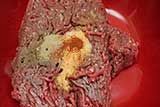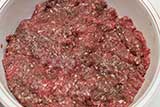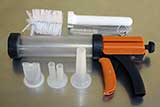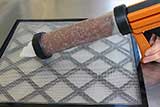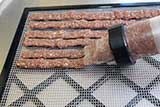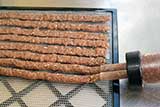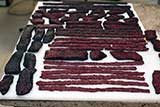Meats and Sausages
Reconstituted - Ground Meat Jerky
A classical jerky is made from whole cuts of meat, however, when made from ground meat, it is known as "reconstituted jerky." The meat is ground up, seasoned, and then extruded into strips or sticks. It is then cooked and/or dehydrated to form the classic jerky structure.
Meat Selection
To make jerky from ground meat, choose 93% lean meat which is available in supermarkets. All meats are suitable: beef, pork, poultry, and wild game. Use only fresh lean meat. Remove any sinews, silver screen, and connective tissue. Those are great parts for emulsified sausages, but in jerky they will be very hard to chew. Discard any fat as it becomes rancid in time and will lower the flavor of jerky. There are more bacteria in ground meat than in whole meat strips so use as fresh meat as possible.
Manufacturing Process
1. The meat is ground and mixed with spices.
Add 1.8% salt in relation to meat weight. This comes to 18 g salt (3 tsp) per 1 kg (2.2 lb) of meat. Add salt and mix with meat well, knead the mixture hard until it becomes sticky. You may add 120 ml (1/2 cup) Worcestershire sauce, which goes extremely well with all types of jerky or other liquid ingredients. Worcestershire sauce is very acidic and, like vinegar, inhibits the growth of bacteria. You can add tomato ketchup, vinegar, or lemon juice, those are the typical ingredients of a good marinade. Those ingredients can be mixed in varying proportions, it is up to you. Although adding moisture will extend the drying time, nevertheless it provides new flavors and makes the stuffing and forcing jerky out of the jerky gun much easier.
Spices and flavorings
Liquid smoke will add a smoky flavor, and Tabasco sauce or pepper will add hotness. Be careful with liquid smoke, too much will make jerky bitter. Start with one teaspoon per 1 kg (2.2 lb) of meat and taste. Do not over salt, remember that jerky will lose moisture, but the salt will remain inside. Keep in mind that adding soy sauce brings a lot of salt as well. Add spices of your choice: pepper, sugar, mustard, cumin, nutmeg, powdered garlic, powdered onion, marjoram, curry, etc.
Taste the mixture, there is still time for changes.
There is no need for cure #1 (sodium nitrite), unless you want jerky to be red.
A sample recipe:
- 1 kg (2.2 lb) lean ground beef
- Salt, 18 g (3 tsp)
- Pepper, 1 tsp
- Ground cumin or caraway, 1/2 tsp
- Nutmeg, 1/2 tsp
- 2 Tbsp Worcestershire sauce
- 1 tsp Tabasco sauce
- 2 tsp liquid smoke
2. Jerky is formed by a specially designed jerky gun.
3. Jerky sticks are placed on the screen and dried in a dehydrator. Follow the dehydrator manufacturer’s directions for drying. Drying temperatures for jerky are usually between 145° F (63° C) and 155° F (68° C). As with whole meat jerky, an internal temperature of 160° F (72° C) is necessary to eliminate disease-causing bacteria such as E. coli O157:H7, if present.
It is difficult to provide an exact number of hours needed to dry jerky. This depends on the thickness of the meat, temperature, humidity, and the type of dehydrator. Start checking jerky after 3 hours. Dried jerky cracks but does not break when it is bent.
When drying is completed remove any spots of oil with a paper towel. Cool. Pack in plastic zip-lock bags or in glass jars. If droplets of moisture appear, the jerky is still moist, so dry it for another hour or so.
Storing the Jerky
For best quality store dried jerky:
- In a sealed container for 1-2 weeks at room temperature
- Up to 6 months in the refrigerator.
- Up to 12 months in the freezer.
Vacuum package jerky to extend its shelf life.

